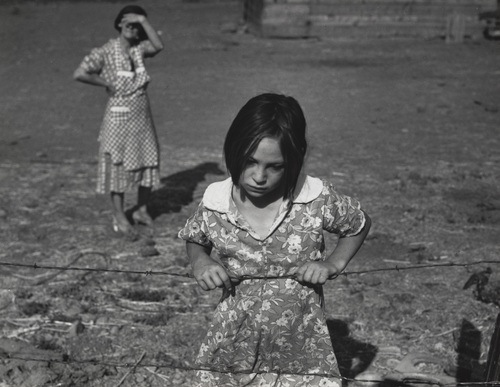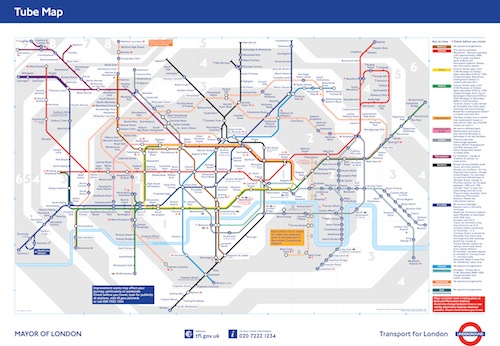The Eyes of Technology
Posted on October 26, 2012 | posted by:The Transdisciplinary Design program is made up of intangibles, where time is our medium. Coming into the program with a Fine Arts background, I understand history is not a testament to the truth; we cannot rely on pictures and paintings for honesty of history. Take Dorothea Lange’s photograph below. The viewers assumptions are built simply by the artists compositional choices; perhaps the two figures are related, or the young girl is distressed, or the cut off structure is their home. We do not know for sure that these assumptions are true. Empirical thought has depleted our view of our surroundings due to a filtered view through the eye of an apparatus.
This piece deals with the differences between natural time and real time. Natural time is the time that passes as the earth turns and seasons change. Before train schedules farmers worked according to the sun’s cycle. Real time, as it appears in this piece, was created so the public could be coordinated with the train schedules. It is artificial increments that we base our life around.
Since Eadweard Muybridge revolutionized photography in 1878 by capturing motion photographically without blur, our perception of natural time and space has strayed. There is a difference in the time that a camera sees and the time that our eyes see; rapid motion that we take for granted can now be caught in a still frame. Technology sees our body as a barrier for humans to succeed, therefore, when talking about time and space, in the modern sense, it directly means accelerating communications and transportation. We are now living at the speed of the artifice rather than the speed of nature. Muybridge found a way to freeze the water of passing time; we are no longer stuck within the constraints of naturality. We are observing a life that does not move, but living in one that does. What does this all mean for a designer? Does the impact on perception and consciousness mean losing the power to imagine?
Now more than ever, we have tools and apparatuses that allow us to record history seemingly accurately, but for a designer it is not enough to cite the products of our apparatuses. We must overcome the preconceptions and produced perceptions of places and time.
We cannot go back to nature; we are in a realm of the artifice and have to use this to our advantage. Designers are mediators; connecting fiction and reality, natural and artificial, public and engineering, and humans and their environment. The perceptions produced by technology should not be seen as a barrier, but an opportunity. Given the opportunity to see our time and space in something other than in its natural form allows us to simplify and understand our surroundings. Representations artists and designers create are intended not to deceive, but enlighten the audience or user. It is sometimes necessary to distort the truth to make something work.
My point is not to say designers are trying to trick people, rather our goal is to be faithful to a situation. However, the play between the fictive and real is necessary. The disconnection between man and his environment, and between real time and natural time is a perfect way to intervene as a designer, to capture the users attention to get them to recognize the space they live in.
So, ‘does the impact on perception and consciousness mean losing the power to imagine?’ No. Designers find uncomplicated ways to address complicated and conceptual spaces. An example given in Clive Dilnot’s class, Design for this Century, was the London Underground. The early maps were based on geographic city maps overlaid on geographic features and main roads. Now through simplification, in 1933 Harry Beck has created a map based on experience rather than actuality, and being a user himself, Beck had an understanding of the system. The design works not because it is geographically representative (it is quite the opposite), but because it maps the underground experience through simplicity.
The Tube being Beck’s apparatus allowed him to see time at a different rate than natural speed. It allowed him to grasp the truth in a way where quality is more important than quantity, and as Paul Virilio says in The Vision Machine, ‘truth is made by lack of precision.’ It can be said for all apparatuses, photography and transportation alike, that ‘the basic concept of physical dimension […] progressively [loses] its meaning and analytical power as a form of dissecting or dismounting perceptive reality. Instead we find other, electronic means of evaluating space and time, ones that share no common ground with the measuring systems of the past.’ (Paul Virilio, Lost Dimension, 30). Using other means of evaluating space and time allows us to look at situations in a new light and be innovative with our designs.
Design is a means for understanding the artificial and ‘our representation of things, as they are given, does not conform to these things as they are in themselves, but that these objects as appearances, conform to our mode of representation.’ (Crary, Techniques of the Observer, 5). It was important in Beck’s case that he was a user of the Tube, where he could understand the users’ experience of the apparatus. Through art and design, we are creating an artificial world. We should still think speculatively about technology and apparatuses that evolve from our artifice, but embrace the perceptions and approach the world through the apparatus.
London Transport Map “Design Classics.” Home. Transport for London, n.d <http://www.tfl.gov.uk/corporate/projectsandchemes/2443.aspx>.
Child and Her Mother, Apato, Yakima Valley, Washington by Dorothea Lange “The Collection.” MoMA.org. N.p.,n.d. Web. 26 Oct. 2012. <http://www.moma.org/collection/browse_results.php?criteria=O%3AAD%3AE%3A3373&page_number=20&template_id=1&sort_order=1>


